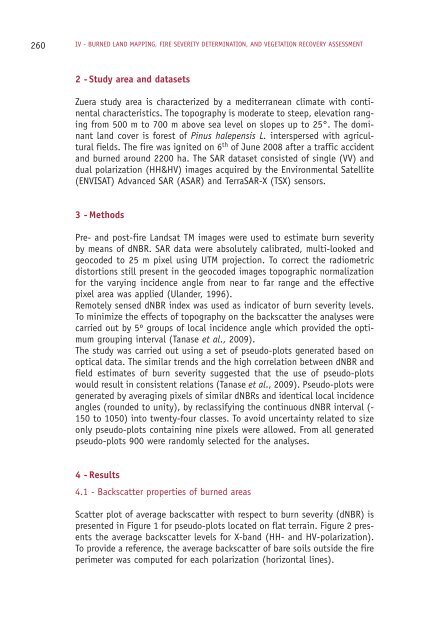7th Workshop on Forest Fire Management - EARSeL, European ...
7th Workshop on Forest Fire Management - EARSeL, European ...
7th Workshop on Forest Fire Management - EARSeL, European ...
Create successful ePaper yourself
Turn your PDF publications into a flip-book with our unique Google optimized e-Paper software.
260<br />
IV - BURNED LAND MAPPING, FIRE SEVERITY DETERMINATION, AND VEGETATION RECOVERY ASSESSMENT<br />
2 - Study area and datasets<br />
Zuera study area is characterized by a mediterranean climate with c<strong>on</strong>tinental<br />
characteristics. The topography is moderate to steep, elevati<strong>on</strong> ranging<br />
from 500 m to 700 m above sea level <strong>on</strong> slopes up to 25°. The dominant<br />
land cover is forest of Pinus halepensis L. interspersed with agricultural<br />
fields. The fire was ignited <strong>on</strong> 6 th of June 2008 after a traffic accident<br />
and burned around 2200 ha. The SAR dataset c<strong>on</strong>sisted of single (VV) and<br />
dual polarizati<strong>on</strong> (HH&HV) images acquired by the Envir<strong>on</strong>mental Satellite<br />
(ENVISAT) Advanced SAR (ASAR) and TerraSAR-X (TSX) sensors.<br />
3 - Methods<br />
Pre- and post-fire Landsat TM images were used to estimate burn severity<br />
by means of dNBR. SAR data were absolutely calibrated, multi-looked and<br />
geocoded to 25 m pixel using UTM projecti<strong>on</strong>. To correct the radiometric<br />
distorti<strong>on</strong>s still present in the geocoded images topographic normalizati<strong>on</strong><br />
for the varying incidence angle from near to far range and the effective<br />
pixel area was applied (Ulander, 1996).<br />
Remotely sensed dNBR index was used as indicator of burn severity levels.<br />
To minimize the effects of topography <strong>on</strong> the backscatter the analyses were<br />
carried out by 5º groups of local incidence angle which provided the optimum<br />
grouping interval (Tanase et al., 2009).<br />
The study was carried out using a set of pseudo-plots generated based <strong>on</strong><br />
optical data. The similar trends and the high correlati<strong>on</strong> between dNBR and<br />
field estimates of burn severity suggested that the use of pseudo-plots<br />
would result in c<strong>on</strong>sistent relati<strong>on</strong>s (Tanase et al., 2009). Pseudo-plots were<br />
generated by averaging pixels of similar dNBRs and identical local incidence<br />
angles (rounded to unity), by reclassifying the c<strong>on</strong>tinuous dNBR interval (-<br />
150 to 1050) into twenty-four classes. To avoid uncertainty related to size<br />
<strong>on</strong>ly pseudo-plots c<strong>on</strong>taining nine pixels were allowed. From all generated<br />
pseudo-plots 900 were randomly selected for the analyses.<br />
4 - Results<br />
4.1 - Backscatter properties of burned areas<br />
Scatter plot of average backscatter with respect to burn severity (dNBR) is<br />
presented in Figure 1 for pseudo-plots located <strong>on</strong> flat terrain. Figure 2 presents<br />
the average backscatter levels for X-band (HH- and HV-polarizati<strong>on</strong>).<br />
To provide a reference, the average backscatter of bare soils outside the fire<br />
perimeter was computed for each polarizati<strong>on</strong> (horiz<strong>on</strong>tal lines).
















